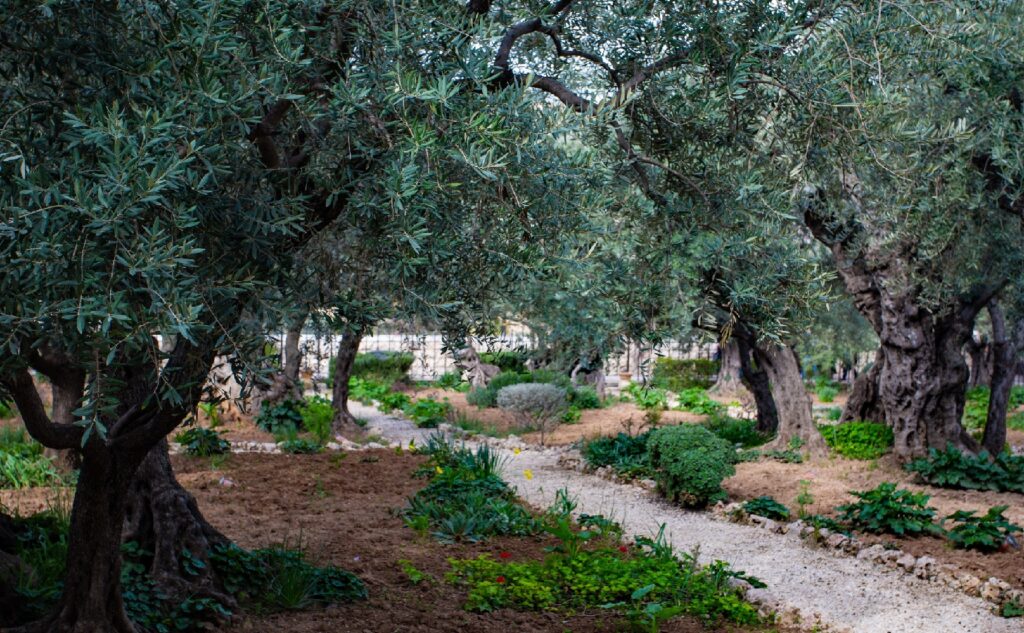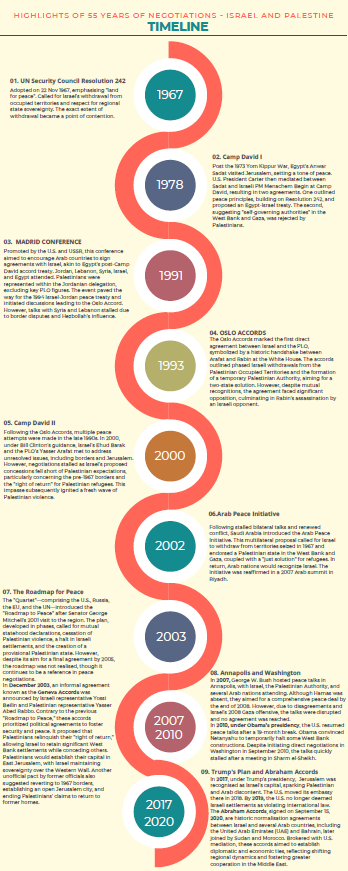Through the Kaleidoscope: Legacy, wounds and the quest for a future in Israel and Palestine
by Dr Joana de Deus Pereira, Senior Research Fellow, RUSI Europe
23 October 2023
The Israel-Palestine conflict, reminiscent of the ever-shifting patterns within a kaleidoscope, is deeply entrenched in a labyrinthine history of territorial disputes and intricate socio-political ties. Each turn in this geopolitical kaleidoscope brings forth a different pattern of narratives and grievances, reflecting the myriad perspectives, emotions, and historical contexts.
Since the establishment of the State of Israel in 1948, both sides have borne profound emotional wounds. For Palestinians, the aftermath of the 1948 Nakba represents a disruption in their cultural lineage, with the echo of displacement reverberating through generations. This longing for their homeland is juxtaposed with Israelis’ collective consciousness, influenced by the shadows of the Holocaust and centuries of persecution, creating a pervasive sense of vulnerability and an unwavering commitment to safeguard their national identity.
Extremist incidents have left scars on both sides. The mutual loss of loved ones and the subsequent cultural mourning have further ingrained these tragedies into the fabric of their identities. Moreover, religious and cultural ties to the land, passed down over generations, intertwine with contentious claims over sacred sites, further exacerbating the conflict.
In a world awash with fast-consuming political and geopolitical analysis, and a massive disinformation war, the weight of such underlying grievances and international legal framework that fuel the conflict’s persistence is often overlooked.
Root Causes and grievances
The Israel-Palestine conflict is not merely a product of present-day geopolitical manoeuvrings, but underlyingly an enduring memory war entrenched in the psyches of both sides. These collective memories, punctuated by moments of immense trauma, shape perceptions, and drive present-day reactions, propelling the cycle of violence and distrust.
For Palestinians, the trauma of the Nakba in 1948 stands as an indelible mark on their historical consciousness. As Israel was founded, around 700,000 Palestinians faced displacement from their ancestral lands, sowing seeds of grief and resentment that persist to this day. Contemporary events, like the call for 1 million Palestinians in Gaza to evacuate due to impending military actions, and the severe restrictions imposed to the Palestinians living in the West Bank, do not just represent immediate threats; they evoke the agonising memory of the Nakba. Conversely, the Jewish collective memory is deeply scarred by the Holocaust, an unparalleled catastrophe that decimated six million Jews. When faced with threats from groups like Hamas, many Israelis do not merely see contemporary security challenges; they discern echoes of past existential threats. This trauma was encapsulated by Israel’s very genesis, intended as a sanctuary for the Jewish community after the horrors of World War II. While no tragedy of was seen to be comparable to the Holocaust in last century, there has been a shift in recent years. Lines are more often blurred and recent attacks evoking the continual emotional resonance of the atrocities of the 1941-1945.
The persistent conflict has fomented radicalisation on both sides. On one hand, groups like Hamas have emerged from a blend of nationalist and religious zeal, advocating for Palestinian rights while using militant and extremist means. On the Israeli side, far-right factions have gained ground, endorsing settlement expansions and hardline policies. This mutual radicalisation cycle has contributed to the perpetuation of violence, making diplomatic resolutions more challenging.
The Kaleidoscope of Proportionality
Established in the early 20th century with roots in the Hague Conventions, and later refined in various international treaties, the principle of proportionality mandates that a response to aggression must be measured, equivalent to the harm endured. They encompass the four 1949 Geneva Conventions and their 1977 Additional Protocols, the 1899 and 1907 Hague Conventions, along with specific weapons treaties. It seeks to maintain an equilibrium, not unlike the patterns within a kaleidoscope, ensuring that retaliatory actions are not only just and immediate, but also constrained to avoid excessiveness.
However, the interpretation of what constitutes a “proportional” response is as varied as the myriad patterns one might witness through a kaleidoscope. In the Israel-Palestine context, the bombing of civilian homes and the siege-like conditions in Gaza raise questions about their legality, especially when essentials like food, water, and medicine are blocked, affecting civilians disproportionately—a clear violation of established International Humanitarian Law (IHL) tenets muddies the waters of proportionality. In this ongoing humanitarian crisis, it becomes apparent that determining proportionality is not just a matter of law, but also one of ethical discernment. Much like interpreting the images within a kaleidoscope, understanding proportionality requires viewing actions within their broader context and recognising the myriad nuances that influence decisions.
The foundational principles of IHL stipulate clear principles: the imperative to distinguish between civilians and combatants and the prohibition of methods that disproportionately affect civilians.
The conflict raises crucial questions on international law, particularly regarding settlements, blockades, and rights of refugees. Numerous UN resolutions have sought to address these, but enforcement remains elusive. Both sides have accused each other of violating the Geneva Conventions, but without consensus in international bodies, definitive legal actions remain stymied. The conduct during hostilities, particularly the imperative to distinguish between civilians and combatants, is paramount. Violations like disproportionate civilian attacks must be scrutinised and international community cannot turn a blind eye.
There is blood in the hands of the Brotherhood
Palestinians are not Hamas. This must be reiterated continually.
Hamas was founded in 1987 during the first Palestinian Intifada. Originating as an offshoot of the Muslim Brotherhood, this entity has grown to be one of the Palestinian territories’ most feared political and militant factions. This connection with the Muslim Brotherhood is not just a footnote in history. The Brotherhood, established in Egypt in the 1920s, has since its inception expanded across the globe, deeply embedding itself in various societies and establishing a widespread network of influence. The mega-dimension of the Muslim Brotherhood’s reach cannot be understated, and their extensive global network poses a considerable risk when mobilised for support.
Hamas began primarily as a community-focused religious organisation in Gaza, building places of worship and gaining local support, before adopting a militant stance. The organisation’s intentions were made clear in its 1988 charter, which not only called for the eradication of Israel but also the establishment of an Islamic society in historic Palestine. In April 1993, Hamas launched the first suicide bombings, five months prior to the landmark Oslo Accords agreement between PLO’s Yasser Arafat and Israeli leader Yitzhak Rabin. In 1997, the US designated Hamas as foreign terrorist organisation.
The logistics and financial resources required for operations on the scale of the 7/10 attack are extensive. Over the years, there has been growing alarm regarding the sources of Hamas’s funding, much of which comes from nations and entities challenging Israel’s legitimacy. A primary financier is Iran, which provides material, financial assistance, and training, and the second, the complex worldwide network of the Muslim Brotherhood. Funding is undoubtedly the connecting dot that continues to be under-examined.
Disinformation Amidst the Echoes of Tragedy
The cacophony of war is not only the thunder of artillery and the cries of the wounded; it is also the tangled weave of narratives, biases, and impassioned claims. With both sides suffering staggering civilian casualties and heart-rending devastation, a common thread persists: the haunting uncertainty, the “blurriness,” that surrounds the specifics of each event. Biases and misinformation have largely amplified the background noise about the last two weeks and have emerged as a plague as destructive and pervasive as the events themselves. It has further muddied the waters, eroding trust and obstructing any possible channel of communication.
The stark brutality faced by both Israelis and Palestinians in this short span is undeniable. Independent, unbiased investigations are not merely advisable – they are imperative. They offer the potential to sift through the rubble of accusation and counter-accusation.
The weight of responsibility should lay with international neutral bodies and neutral third-party organisations to spearhead on-ground examinations. This is not just to assign blame, but to pave the way for understanding, stability, and a possible resolution.
The poignant plea is for clarity amidst chaos. For in acknowledging the undeniable fact, at the date this piece is being written, over 4,200 civilians have perished on both sides according to the UN,. Additionally, around 199 Israelis remain hostages by Hamas in Gaza, whose fate is uncertain.
Conclusion
The Israel-Palestine conflict, like the ever-changing patterns in a kaleidoscope, remains one of the most complex geopolitical challenges of our time. Rooted in a history of collective trauma, the narrative is punctuated by heart-wrenching episodes of violence, strategic manoeuvrings, and the perpetual tug-of-war between memory and geopolitics. Emotions can be weaponised and re-ignited.
As events unfold and the death toll rises, the international community must rise above partisanship, recognising the human cost on both sides and working tirelessly towards a just and lasting peace. This journey, undoubtedly arduous, begins with a commitment to truth, reconciliation, and a refusal to allow history’s shadows to dictate the future.
The views expressed in this Commentary are the author’s, and do not represent those of RUSI Europe or any other institution.

More about the author:
Dr Joana de Deus Pereira, Senior Research Fellow, RUSI Europe

